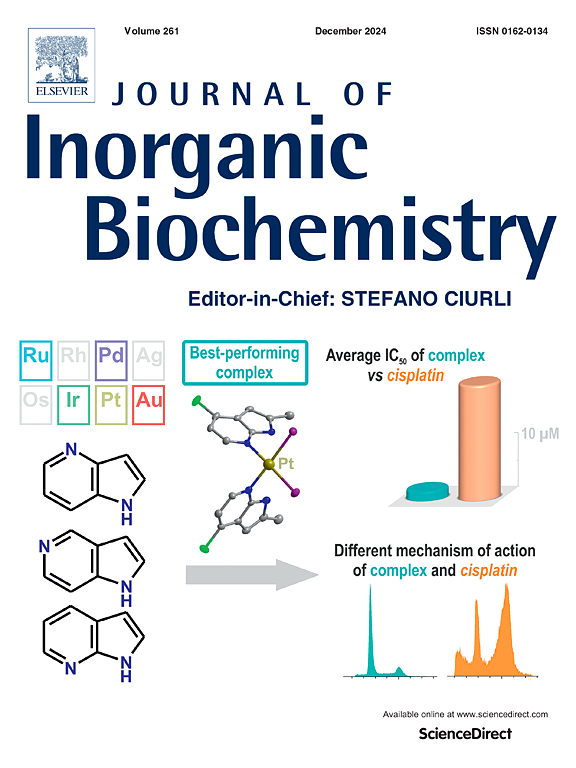向日葵粕蛋白水解物中Ni2+结合肽的鉴定,以加深对肽-金属相互作用的理解
IF 3.8
2区 化学
Q2 BIOCHEMISTRY & MOLECULAR BIOLOGY
引用次数: 0
摘要
向日葵(Helianthus annus L.)是世界上重要的油料作物之一。葵花籽粕的副产品蛋白质含量高,在榨油后可作为多种食品的潜在替代品。金属结合肽来源于食物蛋白水解物,作为预防金属氧化和疾病的生物活性化合物而受到人们的关注。本研究旨在利用IMAC、switchSENSE®、UV-vis和CD技术研究向日葵粕蛋白水解物和理论上存在于向日葵蛋白中的十种肽的Ni2+结合能力。分别使用Protamex®(Prot)和Protamex随后使用Flavourzyme®(Prot+Flav)进行单次和顺序酶处理以产生水解产物。富集Ni2+结合肽的MS/MS分析显示,不同水解产物中含his肽的组成不同;然而,与含his的纯肽相似,所有水解产物在IMAC中的Ni2+结合能力几乎相同。相反,switchSENSE®研究表明,向日葵肽的Ni2+结合能力不仅取决于His残基的存在,还取决于它们在多肽链上的位置和脯氨酸的存在,这表明Prot水解产物具有最高的Ni2+结合能力。UV-vis和CD数据证实,向日葵肽通过His残基的咪唑侧链、去质子酰胺键和n端氨基上的氮原子与Ni2+结合,表明所形成的配合物具有方平面和八面体的几何形状。最后,不含脯氨酸的含his肽可以为从葵花籽粕副产品中设计金属结合肽提供一种合适的策略,其中最有希望的基序是LLHVT和WLH。本文章由计算机程序翻译,如有差异,请以英文原文为准。

Identification of Ni2+-binding peptides in sunflower meal protein hydrolysate for deeper understanding of peptide-metal interactions
Sunflower (Helianthus annus L.) is one of the most important oil crops in the world. Once oil extracted, sunflower meal by-product could offer a potential alternative for various food applications due to its high protein content. Derived from food protein hydrolysates, metal-binding peptides have attracted attention as bioactive compounds to prevent metal-induced oxidation and diseases. This study aimed to investigate the Ni2+-binding ability of sunflower meal protein hydrolysates and ten peptides theoretically present in sunflower proteins using IMAC, switchSENSE®, UV–vis and CD techniques. Single and sequential enzymatic treatments were applied to produce hydrolysates using Protamex® (Prot) and Protamex followed by Flavourzyme® (Prot+Flav), respectively. MS/MS analysis of enriched Ni2+-binding peptides fractions revealed different composition of His-containing peptides among hydrolysates; however, similar to the His-containing pure peptides, the Ni2+-binding ability of all the hydrolysates was almost identical in IMAC. On the contrary, switchSENSE® studies indicated that the Ni2+-binding ability of sunflower peptides does not depend only on the presence of His residues, but also on their position along the polypeptide chain and the presence of proline, suggesting that Prot hydrolysates exhibited the highest Ni2+-binding ability. UV–vis and CD data confirmed that sunflower peptides bound onto Ni2+ through nitrogen atoms from imidazole sidechain of His residues, deprotonated amide bonds and N-terminal amino group, indicating square-planar and also octahedral geometries in the formed complexes. Finally, His-containing peptides without proline could offer a suitable strategy to design metal-binding peptides from sunflower meal by-product, with the most promising motifs being LLHVT and WLH.
求助全文
通过发布文献求助,成功后即可免费获取论文全文。
去求助
来源期刊

Journal of Inorganic Biochemistry
生物-生化与分子生物学
CiteScore
7.00
自引率
10.30%
发文量
336
审稿时长
41 days
期刊介绍:
The Journal of Inorganic Biochemistry is an established international forum for research in all aspects of Biological Inorganic Chemistry. Original papers of a high scientific level are published in the form of Articles (full length papers), Short Communications, Focused Reviews and Bioinorganic Methods. Topics include: the chemistry, structure and function of metalloenzymes; the interaction of inorganic ions and molecules with proteins and nucleic acids; the synthesis and properties of coordination complexes of biological interest including both structural and functional model systems; the function of metal- containing systems in the regulation of gene expression; the role of metals in medicine; the application of spectroscopic methods to determine the structure of metallobiomolecules; the preparation and characterization of metal-based biomaterials; and related systems. The emphasis of the Journal is on the structure and mechanism of action of metallobiomolecules.
 求助内容:
求助内容: 应助结果提醒方式:
应助结果提醒方式:


